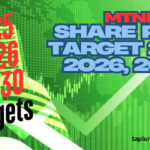Axis Bank is one of India’s leading private sector banks, with a strong presence in retail, corporate, and digital banking. Ranked among the top three private banks in India, Axis Bank has consistently expanded its customer base, technological capabilities, and market share, making it a key player in the financial sector. Investors closely track its stock performance due to its growth potential, stability, and ability to adapt to economic changes.
But why are investors particularly interested in Axis Bank Share Price Target : 60-Month High & Low Predictions for Axis Bank? Unlike short-term trading, a 5-year horizon helps assess the bank’s fundamental strength, macroeconomic resilience, and growth trajectory. Long-term projections allow investors to make informed decisions based on factors like economic cycles, regulatory changes, and the bank’s strategic initiatives—such as digital transformation, loan book expansion, and asset quality improvements.

So, what factors influence Axis Bank’s stock price targets? Key elements include:
- Macroeconomic conditions (GDP growth, inflation, interest rates)
- Bank-specific performance (NPA levels, deposit growth, profitability)
- Regulatory environment (RBI policies, banking reforms)
- Competitive landscape (comparison with HDFC, ICICI, Kotak Bank)
- Global trends (foreign investment flows, geopolitical risks)
Understanding these factors helps investors gauge whether Axis Bank is a strong buy, hold, or sell for the next five years. In this analysis, we’ll explore expert predictions, historical trends, and future growth drivers to help you make a well-informed investment decision.
Axis Bank’s Historical Performance (2019-2024): Trends, Highs & Lows
Axis Bank has witnessed significant fluctuations in its stock price over the past five years, influenced by macroeconomic shifts, regulatory changes, and internal developments. Understanding this historical performance helps investors gauge future potential. Below is a detailed breakdown of key trends, major price movements, and critical events that shaped Axis Bank’s stock trajectory.
Key Milestones & Stock Trends (2019-2024)
| Year | Key Events | Stock Price Range (₹) | Performance Drivers |
|---|---|---|---|
| 2019 | – Leadership transition (Amitabh Chaudhry as CEO) – Strong retail loan growth | ₹600 – ₹850 | Stable NPA management, improved profitability |
| 2020 | – COVID-19 market crash – RBI’s moratorium on loans | ₹350 – ₹550 | Sharp decline due to pandemic fears, rising NPAs |
| 2021 | – Economic recovery – Digital banking expansion (Axis Mobile 3.0) | ₹550 – ₹850 | Revival in credit demand, strong fintech push |
| 2022 | – RBI rate hikes – Acquisition of Citibank’s India retail business | ₹650 – ₹950 | Higher interest margins, strategic expansion |
| 2023 | – Robust quarterly earnings – Global banking crisis impact (SVB collapse) | ₹800 – ₹1,100 | Mixed effects: Strong domestic growth vs. global uncertainty |
| 2024 | – Continued focus on digital lending – Potential inclusion in global indices | ₹900 – ₹1,200* | Optimism around credit growth & profitability |
(Data as of mid-2024)*
Major Highs & Lows (2019-2024)
- All-Time High (2024): ₹1,200+ (Driven by strong earnings & Citibank acquisition synergies)
- Post-COVID Low (2020): ₹350 (Market panic, fears of rising bad loans)
- Recovery High (2023): ₹1,100 (Economic rebound, improved asset quality)
Impact of Economic & Regulatory Events
- COVID-19 Pandemic (2020)
- Stock plunged ~40% due to loan moratoriums and NPA risks.
- Recovery began in late 2020 as digital banking gained traction.
- RBI Policy Shifts
- 2020–2021: Low interest rates boosted lending.
- 2022–2023: Rate hikes improved net interest margins (NIMs).
- Citibank India Acquisition (2022)
- Strengthened Axis Bank’s retail portfolio (credit cards, wealth management).
- Stock surged ~20% post-announcement.
- Global Banking Crisis (2023)
- Short-term volatility due to contagion fears (e.g., SVB collapse).
- Domestic resilience limited long-term damage.
Key Factors Affecting Axis Bank’s Future Share Price (2024-2029)

Axis Bank’s stock performance over the next five years will depend on a mix of macroeconomic conditions, bank-specific fundamentals, regulatory policies, and competition. Below is a detailed breakdown of these critical factors, along with their potential impact on the share price.
1. Macroeconomic Factors
| Factor | Impact on Axis Bank | Key Trends to Watch |
|---|---|---|
| GDP Growth | Higher GDP = More credit demand Boosts retail & corporate loans | India’s GDP growth (~6-7% expected) |
| Inflation | High inflation → RBI rate hikes → Higher NIMs (Net Interest Margins) | RBI’s inflation targeting (4-6%) |
| Interest Rates | Rising rates improve lending profits But may slow loan growth | RBI repo rate decisions (currently 6.5%) |
| Rupee-Dollar Rate | Weak rupee impacts foreign investor sentiment | FII inflows into banking stocks |
Why It Matters?
A strong economy supports loan growth, while inflation and rate decisions directly impact Axis Bank’s profitability.
2. Bank-Specific Factors
| Factor | Impact on Share Price | Recent Performance |
|---|---|---|
| NPA Trends | Lower NPAs → Higher investor confidence | Gross NPA (2024): ~2-3% |
| Loan Growth | Faster growth → Higher revenue | Retail loans up 18% YoY (2024) |
| Digital Transformation | Better efficiency & customer reach | Axis Mobile app (50M+ users) |
| CitiBank Integration | Expands credit card & wealth business | Synergies still unfolding |
Investor Insight:
- Axis Bank’s digital push (like UPI, AI-based lending) could be a game-changer.
- Asset quality (NPAs) remains a critical monitorable.
3. Regulatory Environment
| Policy | Impact on Axis Bank | Recent Changes |
|---|---|---|
| RBI Rate Policies | Higher rates → Better NIMs But may slow borrowing | RBI paused hikes in 2024 |
| Basel-III Norms | Stricter capital requirements | Axis Bank’s CET-1 ratio (~14%) |
| PSU Bank Reforms | More competition if PSU banks improve | Govt’s privatization plans |
Key Takeaway:
Regulatory risks (like tighter NPA norms) could pressure margins, while favorable policies may boost growth.
4. Competitive Landscape (vs. Peers)
| Metric | Axis Bank | HDFC Bank | ICICI Bank | Kotak Bank |
|---|---|---|---|---|
| Market Cap (₹Cr) | ~3.2 Lakh | ~11 Lakh | ~7.5 Lakh | ~3.8 Lakh |
| ROE (2024) | ~16% | ~17% | ~18% | ~13% |
| NIM (%) | ~3.8% | ~4.1% | ~4.0% | ~5.2% |
| Digital Strength | Strong (Axis Mobile) | Leader (PayZapp) | Fast-growing (iMobile) | Lagging |
Competitive Edge:
- Axis Bank vs. HDFC/ICICI: Smaller but more agile in digital lending.
- Kotak’s Challenge: Higher NIMs but slower tech adoption.
5. Global Factors (Bonus Consideration)
- Foreign Institutional Investor (FII) Flows – Impact liquidity & valuations.
- Geopolitical Risks – Oil prices, global recessions affect banking stocks.
Axis Bank Share Price Target (2024-2029): Bullish, Bearish & Moderate Scenarios

Investors looking at Axis Bank for the next 5 years need a clear picture of its potential upside and risks. Below, we break down three possible scenarios—Bullish, Bearish, and Moderate—based on growth drivers, macroeconomic factors, and banking sector trends.
1. Bullish Scenario (High Target: ₹1,400–₹1,800 by 2029)
Key Growth Drivers:
✅ Strong Loan Growth (15%+ CAGR) – Retail & SME lending expansion.
✅ Declining NPAs (Sub-2%) – Better asset quality boosts profitability.
✅ Digital Banking Success – Axis Mobile, UPI, and fintech partnerships gain market share.
✅ Citibank Acquisition Synergies – Higher-margin credit card and wealth management business.
✅ Favorable Macroeconomic Conditions – Stable GDP growth (~6.5%) and controlled inflation.
Projected Price Range:
- 2025: ₹1,100–₹1,300
- 2027: ₹1,300–₹1,500
- 2029: ₹1,500–₹1,800**
Why? If Axis Bank executes well on digital transformation and maintains strong credit growth, it could outperform peers like ICICI and Kotak Bank.
2. Bearish Scenario (Low Target: ₹600–₹900 by 2029)
Key Risks & Challenges:
⚠️ Rising NPAs (>4%) – Economic slowdown leads to bad loans.
⚠️ Stagnant Loan Growth (<10%) – High interest rates reduce credit demand.
⚠️ Regulatory Pressure – Stricter RBI norms on capital adequacy or lending.
⚠️ Competition from Fintech & PSU Banks – Losing market share in digital payments.
⚠️ Global Recession Impact – FIIs pull out, reducing liquidity.
Projected Price Range:
- 2025: ₹800–₹900
- 2027: ₹700–₹850
- 2029: ₹600–₹800**
Why? A major economic downturn or failure in Citi integration could lead to underperformance.
3. Moderate Scenario (Base Case: ₹1,000–₹1,300 by 2029)
Balanced Outlook:
🔹 Steady Loan Growth (12% CAGR) – Aligns with industry average.
🔹 NPAs at 2-3% – No major deterioration in asset quality.
🔹 Moderate Digital Growth – Holds its position but doesn’t disrupt the market.
🔹 Stable Macro Environment – No major RBI rate shocks or recessions.
Projected Price Range:
- 2025: ₹900–₹1,100
- 2027: ₹1,000–₹1,200
- 2029: ₹1,100–₹1,400**
Why? This is the most likely scenario if Axis Bank grows steadily without major setbacks or breakthroughs.
Axis Bank Share Price Forecast: Expert Analyst Predictions (2024-2029)

Investors rely heavily on brokerage reports and analyst outlooks to gauge Axis Bank’s future potential. Below, we compile insights from top global and domestic brokerages, along with a comparison of technical vs. fundamental analysis perspectives.
1. Top Brokerage Views on Axis Bank
| Brokerage Firm | Rating | Target Price (1-2 Years) | Key Reasoning |
|---|---|---|---|
| Morgan Stanley | Overweight | ₹1,250 | Strong digital banking growth & improving NIMs |
| Goldman Sachs | Buy | ₹1,300 | Citi acquisition synergies to boost fees & retail loans |
| JP Morgan | Neutral | ₹1,050 | Concerns over rising competition in retail lending |
| ICICI Securities | Hold | ₹1,100 | Steady growth but priced in near-term |
| Kotak Institutional | Sell | ₹900 | Expect margin pressure due to deposit rate hikes |
Key Takeaways:
✔ Bullish Analysts (Morgan Stanley, Goldman Sachs): Believe in digital transformation and Citi integration benefits.
✔ Neutral/Sell Calls (JP Morgan, Kotak): Worried about rising funding costs and slowing deposit growth.
2. Technical Analysis Outlook (Charts & Trends)
Short-Term (1-2 Years)
- Current Price (2024): ~₹1,100
- Support Levels: ₹950 (Strong Demand Zone)
- Resistance Levels: ₹1,200 → ₹1,350 (Breakout Zone)
- RSI (14-day): ~60 (Neutral, not overbought)
- Moving Averages:
- 50-Day EMA: ₹1,050 (Short-term trend support)
- 200-Day EMA: ₹980 (Long-term bullish indicator)
Long-Term (5 Years)
- If ₹1,200 is breached, next target: ₹1,500+ (Bullish Momentum)
- If falls below ₹950, risk of decline to ₹800-850 (Bearish Trend)
Technical Verdict:
- Break above ₹1,200 could trigger a major rally.
- Fall below ₹950 may indicate a downtrend.
3. Fundamental Analysis Outlook
Key Metrics (2024-2029 Forecasts)
| Parameter | Current (2024) | 2026E | 2029E |
|---|---|---|---|
| EPS (₹) | 85 | 105 | 140 |
| ROE (%) | 16% | 17% | 18% |
| NIM (%) | 3.8% | 4.0% | 4.2% |
| Loan Growth (CAGR) | 15% | 14% | 13% |
Valuation (Is Axis Bank Undervalued?)
- P/E Ratio (2024): ~13x (vs. HDFC Bank’s 18x)
- Price-to-Book (P/B): 2.1x (Below ICICI’s 2.8x)
- Dividend Yield: ~1.2% (Lower than SBI’s 2.5%)
Fundamental Verdict:
- Attractive vs. Peers (Cheaper than HDFC/ICICI).
- Growth Potential: If NIMs improve, stock could re-rate higher.
4. Technical vs. Fundamental: Which is More Reliable?
| Factor | Technical Analysis | Fundamental Analysis |
|---|---|---|
| Focus | Price trends, charts | Financials, growth metrics |
| Time Horizon | Short-term (1-3 yrs) | Long-term (3-5+ yrs) |
| Best For | Traders | Investors |
| Key Risk | False breakouts | Overlooking market sentiment |
Final Take:
- Short-term traders: Watch ₹1,200 resistance and ₹950 support.
- Long-term investors: Focus on loan growth, NPAs, and digital adoption.
5. Consensus Price Target for 2029
- Low Estimate: ₹800 (Bear Case – Rising NPAs, Slow Growth)
- Base Case: ₹1,100–₹1,300 (Moderate Growth)
- High Estimate: ₹1,500–₹1,800 (Bull Case – Digital & Citi Success)
FAQs on Axis Bank Share Price Target
1. Will Axis Bank reach ₹1,500 in 5 years?
✅ Possible in a Bullish Scenario – If loan growth stays strong (15%+ CAGR), NPAs remain low (<2%), and digital banking gains traction, Axis Bank could hit ₹1,500–₹1,800 by 2029.
2. What is the 5-year CAGR expectation?
📈 Moderate Estimate: 10–12% CAGR – Assuming steady growth, Axis Bank could deliver ~12% annual returns, reaching ₹1,100–₹1,300 by 2029.
3. How do dividends impact long-term returns?
💰 Low but Steady Payout (~1.2% Yield) – Dividends add minor returns, but capital appreciation (stock price growth) will drive most gains. Reinvesting dividends can boost overall CAGR.
4. Is Axis Bank better than private peers for long-term holding?
🏦 Depends on Risk-Reward Preference:
- vs. HDFC Bank: More stable but slower growth.
- vs. ICICI Bank: Similar growth, but Axis has better digital momentum.
- vs. Kotak Bank: Higher NIMs but weaker tech adoption.
✅ Best for Investors Seeking Growth + Digital Upside.
Disclaimer:
The advice or opinions given on Taplumarket are the personal views of the expert, the brokerage firm, the website or management is not responsible for it. Before investing, please consult your financial advisor or certified expert.







1 thought on “Axis Bank Share Price Target : 60-Month High & Low Predictions”